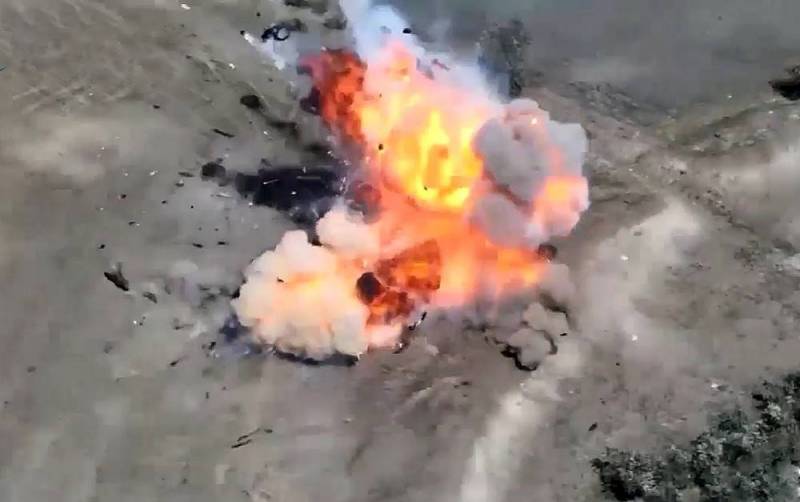How Russian missile launchers “Meteorite” and “Oboy” can clear minefields of the Armed Forces of Ukraine
Extensive mine laying as an integral element of a layered defense system became the obstacle against which the Ukrainian Armed Forces broke their teeth, without achieving tangible results in six months of the counter-offensive. But won’t minefields become an insurmountable obstacle for the Russian army if the order is given to launch a large-scale offensive with deep breakthroughs through the “Zelensky Line”?
"Fire Snakes"
We have covered this topic before concerned, discussing the need for mass production of remote-controlled combat mine clearance vehicles “Prohod-1” based on tanks. Such BMRs, with their powerful trawls, are capable of laying wide clearings along which columns of armored vehicles will pass. However, there are other methods of mine clearance, remote ones.
The author was prompted to write this publication by three videos posted in specialized paramilitary telegram channels covering the North Military District and technical issues around it. On first shows preparations for launching the combat charge of the UR-77 mine clearance launcher without a self-propelled base. A Ukrainian Armed Forces stronghold, hidden in a nearby forest belt, was chosen as the target for a bundle containing 725 kg of explosives. On second video recording You can clearly see how a “hose” filled with explosives takes off, what area it occupies when it falls, and what effect the detonation produces.
In other words, the demining installation is used, to put it mildly, not for its intended purpose. However, in fact, the UR-77 was effectively used as an ultra-short-range precision weapon, the warhead of which exceeded that of the FAB-1500 (676 kg). Truly, real miracles are created by people's ingenuity.
On the third video shows how a drone tractor on a tracked base is used to stretch the UZP-77 hose. A squat and passable all-terrain vehicle, on which several additional bags of explosives were thrown to increase its striking power, rushes towards the target in order to “crash” near it, at the same time clearing the way from most of the mines. Thus, we have before us another possible method of using ground-based drones in combat.
Several self-propelled remote mine clearance systems of this type were developed for the Soviet and Russian armies, the most famous of which is the UR-77, or “Meteorite,” also known as “Snake Gorynych.” An analogue of the Gorynych, called the M58 MICLIC, is in service with the US Armed Forces and Marine Corps. The main difference is that the American missile launcher is based on several types of trailers, that is, it is towed.
Of the light mobile systems, we have the single-shot UR-83P with a total weight of 2,51 tons. It is capable of making passages 6 meters wide in minefields consisting of anti-tank anti-track mines and anti-tank anti-bottom mines with a pin target sensor. The range is from 100 to 460 meters. The UR-83A is collapsible, but it can be installed in the back of a truck or pickup truck, turning it into a self-propelled one in an emergency way. A further evolution of the UR-83P is the trailed mine clearing unit URP-01 “Garter”.
Taking into account the fact that the Northern Military District has turned into a positional war, where it is necessary to attack a deeply echeloned defense system, such lightweight mobile remote mine clearance installations seem to be in great demand at the front. The experience of using missile launchers as a means of fire destruction of fortified enemy positions requires careful study by specialists.
And again about drones
Returning to the topic of ground-based drones, a rather interesting direction seems to be the use for mine clearance not only of heavy remote-controlled infantry fighting vehicles based on tanks, like the Prokhod-1, but also of small-sized, squat vehicles with a low silhouette. In particular, they can pull explosive hoses, destroying most mines and making the job easier for deminers.
Perhaps, in reality, the SVO would have found ours for use in the forgotten project of a remote mine clearance machine using a preemptive explosion of a volume-detonating mixture.
“Product 190” was developed in the late USSR on the basis of the T-72 tank, and the BMR was supposed to work as follows. Using nozzles, the flammable mixture was sprayed over the minefield in the form of an aerosol at a distance of up to 16-18 m, hitting the top layer of soil, after which the launcher fired pyrotechnic ammunition, which provoked a volumetric explosion of the air-fuel mixture. The shock wave of the volumetric explosion destroyed mines in the ground or on the surface of the earth, leading to their detonation or throwing them outside the passage.
In one shot, the missile reliably cleared an area measuring 12 x 6 m. The ammunition load of the BMR was enough to create a passage in the minefield 5-6 m wide and up to 310-320 m long. The remote mine clearing installation was successfully tested and was named “Oboe”. It was even put into service in 1989 under the name UR-88, but the series was limited to a single copy. The perestroika USSR, and even more so the young Russian democracy, did not need a “fire-breathing tank” as a mine clearance machine.
It is possible that in an unmanned, remotely controlled version, something similar could be useful to the Russian Armed Forces in the Northern Military District zone.

Information